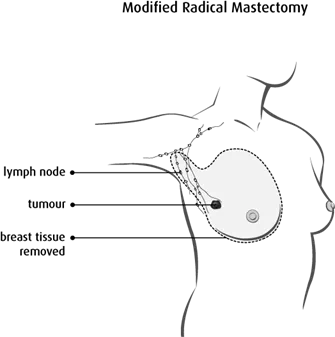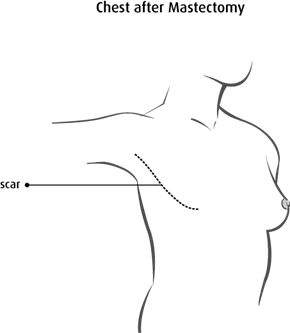Surgery for breast cancer
Most women with breast cancer will have surgery. The type of surgery you have depends mainly on the size and location of the tumour, the size of the breast, if the cancer has spread to the lymph nodes and any other treatments you have already had for breast cancer. When planning surgery, your healthcare team will also consider other factors, such as your overall health and the type of surgery you want to have.
Surgery may be done for different reasons. You may have surgery to:
- completely remove the tumour
- check if there is cancer in or remove lymph nodes
- remove cancer that comes back in the breast (called a local recurrence)
- reconstruct the breast (breast reconstruction)
Chemotherapy may be given before surgery (called neoadjuvant chemotherapy) to shrink a large tumour to make it easier to remove.
The following types of surgery are used to treat breast cancer. In many cases, breast-conserving surgery or mastectomy could be done. Your healthcare team will discuss the options with you to help you decide which is right for you. The type of surgery you choose may affect other treatments you have before or after surgery. Find out more about choosing the breast surgery that is right for you.
Breast-conserving surgery
Breast-conserving surgery is sometimes called a lumpectomy. This type of surgery keeps, or conserves, as much of the breast as possible. In most cases, breast-conserving surgery will be followed by radiation therapy.

Breast-conserving surgery may be offered if the surgeon can safely remove the breast tumour along with a margin of healthy tissue and still leave enough tissue so the breast looks natural. The breast is a little different after breast-conserving surgery, but often the changes are not very noticeable. After surgery, the breast is smaller, slightly different in shape and slightly firmer.
How breast-conserving surgery is done
Breast-conserving surgery is done in a hospital with either a local or general anesthetic. The surgeon makes a small cut, or incision, in the breast over or near the abnormal area. The surgeon removes the abnormal area or tumour along with a margin of healthy tissue around it.
After removing the abnormal area or tumour, the surgeon closes the skin with stitches (called sutures) or special staples. A bandage or dressing is placed over the wound. The healthcare team will remove the stitches or staples once the incision heals. Some types of stitches dissolve on their own.
After breast-conserving surgery
The healthcare team sends the breast tissue to a lab. A pathologist (a doctor who specializes in the causes and nature of disease) examines the edges of the tissue sample for cancer cells.
If there aren’t cancer cells in the edges of the removed tissue, it is reported as clear, or negative, margins.
If there are cancer cells in the edges of the removed tissue, it is reported as positive margins. The surgeon will need to remove more tissue because the cancer cells left behind can grow into another tumour or spread. Another breast-conserving surgery is done to remove more breast tissue from the same surgical site, or a mastectomy is done to remove all of the breast tissue.
Mastectomy
A mastectomy removes all of the breast. It is used to treat tumours that are large compared to the size of the breast. It may be used when the cancer is in more than one area of the breast, or if there are positive margins after breast-conserving surgery. A mastectomy is also done if cancer comes back, or recurs, in the breast after breast-conserving surgery and radiation therapy. You may also choose to have a mastectomy instead of breast-conserving surgery.
Types of mastectomy
The following types of mastectomy may be offered.
Total mastectomy
A total mastectomy, or simple mastectomy, removes all of the breast and the tissue that covers the chest muscles (called the pectoral fascia). The lymph nodes, nerves and muscles in the chest are left in place. The nipple may or may not be removed.

If you plan to have a breast reconstruction, your doctors may try to do a skin-sparing mastectomy when they remove the cancer. A skin-sparing mastectomy is like a total mastectomy except that the surgeon doesn’t remove the skin that covers the breast. This approach means that breast reconstruction can be done with very little scarring that can be seen.
Modified radical mastectomy
A modified radical mastectomy removes all of the breast, the nipple, most or all of the lymph nodes in the armpit and the tissue that covers the chest muscles (called the pectoral fascia). Nerves and muscles are usually left in place.

This type of mastectomy is used for breast cancer that has spread to lymph nodes. It is also used to treat inflammatory breast cancer.
A radical mastectomy is an operation that removes more muscle, lymph nodes and other tissues than a modified radical mastectomy. It is now very rarely used to treat breast cancer.
How mastectomy is done
A mastectomy is done in a hospital while you are under a general anesthetic. After removing the breast and other tissues, the surgeon may place plastic or rubber tubes in the area where the breast was removed or under the arm. These tubes, or drains, remove blood and lymph fluid that collect during healing. The surgeon closes the skin with stitches (called sutures) or special staples. A bandage or dressing is placed over the wound.
Lymph node surgeries
As part of the staging process for breast cancer, the surgeon removes lymph nodes so they can be checked to see if they have cancer in them.
Sentinel lymph node biopsy
A sentinel lymph node biopsy (SLNB) removes the sentinel node to see if there is cancer in it. The sentinel lymph node is the first lymph node in a chain or cluster of lymph nodes that gets lymph fluid from the area around a tumour. Cancer cells will most likely spread to the sentinel lymph node. There may be more than one sentinel lymph node, depending on where the lymph vessels carry lymph fluid from the area around the tumour.
SLNB is offered if the breast tumour is smaller than 5 cm and the axillary lymph nodes can’t be felt during a physical exam. If the sentinel lymph node doesn’t contain cancer, no more lymph nodes need to be removed. If the sentinel node does contain cancer or the doctors can’t find it, a woman may be given a choice of an axillary node dissection or radiation therapy to the area of the axillary lymph nodes.
Find out more about sentinel lymph node biopsy.
Axillary lymph node dissection
An axillary lymph node dissection (ALND) removes the lymph nodes under the arm (called the axillary lymph nodes). It is the type of lymph node surgery most commonly done if breast cancer has spread to the lymph nodes.
Find out more about axillary lymph node dissection (ALND).
After breast cancer surgery
Breast cancer surgery may be done as an outpatient procedure, or you may have to stay in the hospital. How long you stay in the hospital will depend on the type of surgery, your general health and how you feel after surgery.
If the surgeon placed drains during surgery, they may need to stay in place when you go home. The healthcare team will tell you how to take care of the surgical area and the drains when you are at home. The drains are removed when there is little drainage from them.
The healthcare team will remove stitches or staples once the incision has healed. Some types of stitches dissolve on their own.

Side effects
Side effects can happen with any type of treatment for breast cancer, but everyone’s experience is different. Some people have many side effects. Other people have only a few side effects.
If you develop side effects, they can happen any time during, immediately after or a few days or weeks after surgery. Sometimes late side effects develop months or years after surgery. Most side effects will go away on their own or can be treated, but some may last a long time or become permanent.
Side effects of surgery will depend mainly on the type of surgery and your overall health. Surgery for breast cancer may cause these side effects:
- lymphedema
- pain or difficulty moving the arm or shoulder
- numbness and tingling in the arm
- changes to body image and self-esteem
Tell your healthcare team if you have these side effects or others you think might be from surgery. The sooner you tell them of any problems, the sooner they can suggest ways to help you deal with them.
Questions to ask about surgery
Find out more about surgery and side effects of surgery. To make the decisions that are right for you, ask your healthcare team questions about surgery.
